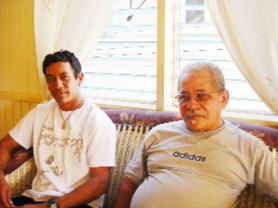Maintaining a balance between preservation of traditional ways and development is the goal of the Wapichan (Wapishana) Amerindian nation of the remote Rupununi Savannahs who are formulating plans to take control of their development.
Representatives of the 17 Wapichan villages located in the remote Deep South and South Central areas of the Rupununi Savannahs in Region Nine met with government agencies and officials over the past week seeking to collaborate on various issues. They got a positive response, Toshao of the Deep South community of Maruranau, Patrick Gomes said.
In light of changing realities including moving to a cash-based economy and with more and more natural resources being utilized, a Management Plan for the Natural Resources of the Wapichan communities is being developed. “If you have a management plan, you will know what you have, you will know how to utilize what you have so it can be sustained”, Gomes told Stabroek News in an interview on Friday.

He said that five areas have been identified for immediate attention with feasibility studies planned for cash crops, livestock and craft. A natural resources management study is to be done to determine the impact of burning on the savannahs and forest while another study is to be done on water quality and fish ecology. Funding has already been approved by the European Union though the South Central Peoples Development Association and the studies will be done by the District Toshaos Council.
Over the past week, the Wapichan team met with the Ministry of Agriculture, the Ministry of Amerindian Affairs, the Ministry of Foreign Affairs, the Guyana Forestry Commission and the Guyana Geology and Mines Commission. Gomes said that they came to share information with the agencies as well as to seek collaboration with the government on initiatives.
The team, comprising Toshaos and other village leaders, falls under the District Toshaos Council of the area. “It was an initiative of the people”, Gomes said. With movement to a cash-based economy away from a barter system, they are seeking ways to merge these two systems. The studies to be done will point the way forward, Nicholas Fredericks, a councillor in the Shulinab Village Council, said.
Gomes said that their approach starts at the bottom and builds up. “The national plan is to see commercial agriculture is developed in the Rupununi. We, on the other hand we are trying in the same way but at our own time and at our own pace”, he said. “You start from what you know and then move on to new things”. A secretariat will be developed to lead the initiative. The current project flows out of two previous ones. A resource mapping project was done in 2003 and then a case study in 2005. Following this, Fredericks said, a management plan was decided as a way to go and consultations were done within all the villages in 2008 and last year.
The communities identified their issues and proposed solutions and they are trying to implement the findings of the study, he said.
He recalled that among the issues that had been raised was cattle rustling, land matters and how the traditional way of agriculture can be transformed. The studies will look at the feasibility of projects. “These studies…are not gonna solve all of our problems, it’s gonna point to a certain direction that the communities can look into generally”, Frederick said adding that the studies will determine what is feasible in terms of projects that can be pursued.
Questioned on whether the plans are distinct from the Community Development Plans that are envisioned under the Low Carbon Development Strategy, Gomes said that it was started long before.
“We started this thing before even the LCDS was made a national policy. So what we’ve been doing is something of our own initiative but it fits into the programme of national government”, he said.
He had noted that their way of life was in sync with conserving the natural resources being advocated under the LCDS. “Our lifestyle in itself support that programme but we would like to be more involved in any decision that is being made, policies are developed, how it is developed under the programme”, Gomes said. He cautioned that many of the projects are “beyond the horizon” and will take some time to realize.




